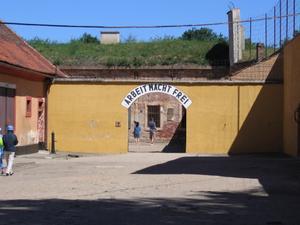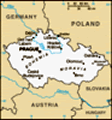Advertisement
Published: June 18th 2005

 Arbeit Macht Frei
Arbeit Macht Frei
The famously ironic Nazi slogan, "work makes [you] free", at the Terezín labor camp where thousands of Bohemian and Moravian Jews and other prisoners were worked to death.Greetings again from Praha (Prague)!
Today I believe I have been successful at entertaining myself. I did, indeed, get up earlyish and catch a guided bus tour to Terezín (Theresienstadt in German), a former Nazi concentration camp and Jewish ghetto located about 60 km north of Praha. The bus tour was definitely the right way to go... because the entire town of Terezín comprises the museum, specific sights are located rather far from each other. My feet were grateful to have a shuttle between them, enough so that I think I can live with the prescribed itinerary and (reasonable) time limits at each stop.
We left at 9:45 from Náměstí Republiky and the trip immediately began to pay for itself as we drove through the northern suburbs of Praha. As I mentioned yesterday, for the most part modern buildings (be they socialist or post-socialist) are not visible from the center of Praha, so this was my chance to see how the rest of this huge (1.2 million) city lives. As expected, things were a mix of towering socialist block housing (equivalent, in many ways, to urban "projects" in the USA), modern high-rise and low-rise apartments, eventually spreading out into

 Muzeum ghetta at Terezín
Muzeum ghetta at Terezín
The illuminated red stripes on the museum floor represent the rails by which nearly everyone in Terezín was, eventually, transferred to Auschwitz or another eastern extermination camp.middle-class suburbs and finally opening up into broad farmland. The weather was perfect and the scenery gorgeous.
At Terezín, we had a guided tour through the Malá pevnost (Small Fortress), then self-guided walks through the Muzeum ghetta (Museum of the Ghetto) and the Magdeburská kasárna (Magdeburg Barracks) in the Large Fortress. We finished with a stop at the Jewish Cemetery and Krematorium (which was closed, it being Saturday) before returning to Praha.
Terezín was not a death camp, but a concentration camp and transit camp on the way to the death camps further east. The Nazis used it as a showpiece to convince the Red Cross (successfully) that they weren't interested in exterminating Jews, just relocating them to places of "their own" segregated from Aryans (the Serbians in Bosnia and Kosovo in the 1990s coined the term "ethnic cleansing" to describe exactly the same thing, as in, "don't worry, it's
only ethnic cleansing"; they were lying, too). The Nazis even made a propaganda film at Terezín, showing laughing, happy, well-fed Jews watching football and jazz orchestras. Parts of it survive and were incorporated into a larger film that we got to see. Materials at the museum say that

 Baroque/rococo trompe l'oeil ceiling
Baroque/rococo trompe l'oeil ceiling
This lovely art was in the "Baroque library", where I enjoyed one of Prague's many, many classical concerts.the most stereotypically Jewish-looking of the Jews were dressed up and forced to participate, while others were forced to clean up the town and build showpiece facilities (such as a "shaving room" at the prison, which was never used) for the inspectors' benefit.
At the small fortress, where political prisoners and dissidents were held, tortured, and sometimes executed, the conditions are similar to what we expect of a "concentration camp", on a small scale. The ghetto is more unusual and perhaps more chilling. The town of Terezín lay inside the "large fortress", and in 1941 the Nazis evicted the entire civilian population (about 7,000) and moved Jews in (about 60,000). Although conditions were deprived and horribly overcrowded (our 30-odd tour group would cram ourselves awkwardly into rooms, only to be told that the rooms had housed 60 people for years), Jews at Terezín were able to maintain aspects of a normal life during their time there. Their "dormitories" were stifling and overcrowded, but still they had their own limited possessions. They performed theater, published literary magazines and composed and performed music. Special attention was paid to the welfare and psychological health of children, who were taught all subjects by Czechia's finest (Jewish) professors at secret schools, and produced drawings and other works of art to help them express their feelings. The adults took it upon themselves to make sure these children had a chance at normal lives, but hardly any of those children survived the war. Nearly all children, and most adults (over 150,000 total), who passed through Terezín were transferred to extermination camps in Poland and Russia and were killed or died there. It is chilling to see huge exhibits of children's art, the sort of thing one would see at any grade school, where nearly every item has the child's date of death labelled underneath.
Even worse, toward the end of the war, the Nazis hurriedly transferred prisoners back from the extermination camps into Terezín, in an attempt to stay ahead of and hide their crimes from the advancing Red Army. These prisoners brought epidemics of typhus and dysentery so severe that the entire town was quarantined long after the war, and thousands of those who had managed to avoid the extermination camps, died anyway of disease.
(The final creepy thing about Terezín is that most of it is a town again, and people
live in it, go about normal lives, raise kids, shop, etc. Our Czech tour guide said she doesn't understand it either, but rents are said to be
extremely cheap there.)
All in all, this town was entirely worth seeing, and I think doing so solo, with lots of time to absorb and reflect, was exactly appropriate.
Upon returning to Praha, I was in the mood for some serious comfort, so I turned to the Dark Side and had dinner at a TGIFriday's on Na Přikopě (a former moat, now a street and living monument to tourist consumerist capitalism). Traditional local food is great and all, but given that I'm here an entire month, I really think I'm entitled to one day for American-style ribs and a smoothie.
Finally, I ventured back into town to find me a concert. Staré Město (old town) is packed with locals handing out flyers for this, that and the other musical event, but there are a few ticket-sellers where you can go to see a complete listing of everything scheduled for today and tomorrow. I found a little quartet (soprano, harp, violin and very odd small wooden-pipe organ) playing a variety of classics in a beautiful Baroque former library with trompe l'oeil ceiling. The soprano was exceptional, and the harpist and violinist excellent also, but the poor organist was way in over her head and perpetrated what Greg will recognize as "organist rhythm". We were treated to short selections by Mozart, Bach, Händel, Vivaldi, and of course Dvořák and Smetana (Czech composers). The Largo from Dvořák's Symphony No. 9, "From the New World" seemed to have been sung in Czech, but it is also recognizable as the (later!) popular English song "Goin' Home".
Now it's time for me to pack up and turn in. Tomorrow morning, I've got to check out early and stash my suitcase at the train station before church at 9:30. I hope to see a couple of small museums in the afternoon, then catch my train to München (Munich) at 17:00, arriving near midnight (yawwwn). I'll be sleeping in on Monday and then reorienting and back on the hunt for internet access!
Advertisement
Tot: 0.2s; Tpl: 0.01s; cc: 12; qc: 52; dbt: 0.089s; 1; m:domysql w:travelblog (10.17.0.13); sld: 1;
; mem: 1.2mb









Mom
non-member comment
Architecture
Those old fancy buildings with lots of detail and art painted ceilings and walls were my very favorite in Vienna. The web gives pictures of those on your trip and they makes me drool! Enjoy!